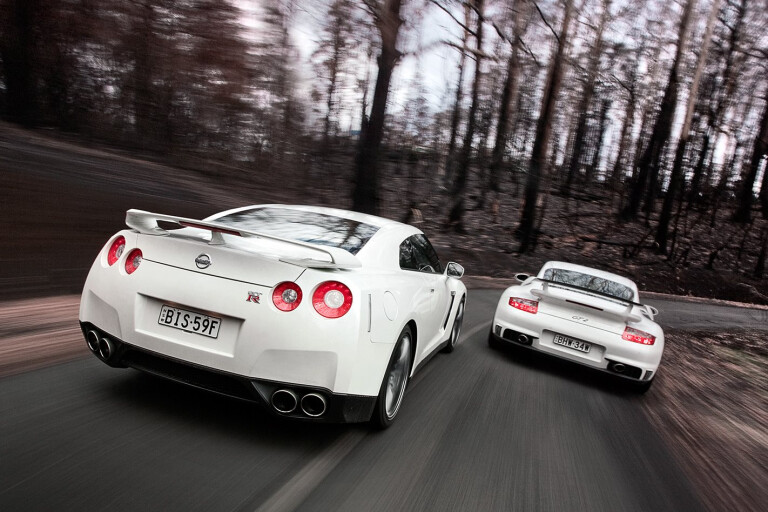
Let’s get something straight right from the get-go – this isn’t a normal two-car comparison.
This article was originally published in the June 2009 issue of MOTOR magazine.
How can it be when the fresh meat – Nissan’s manga-hero GT-R Premium – costs just $159,900, while the established player – Porsche’s all-conquering 911 GT2 – asks $447,500?
It’s a test that just doesn’t compute, and yet it’s also one that makes total sense. Besides, what do you compare the new-generation Godzilla with? An Audi S5? A five-star adventure tour of New Zealand?
 Only weeks ago, Nissan’s new GT-R (admittedly in Spec V guise) lapped the Nurburgring in a record 7min 27.56sec – faster than any Porsche in history, including the current GT2.
Only weeks ago, Nissan’s new GT-R (admittedly in Spec V guise) lapped the Nurburgring in a record 7min 27.56sec – faster than any Porsche in history, including the current GT2.
Naturally, the boffins at Stuttgart reckon it’s bullshit, so prepare for the war of words and numbers to continue in the coming months. But in Australia, right here and now, if the GT-R had an adversary to beat, it’s this magazine’s reigning Performance Car of the Year champion – the Porsche 911 GT2.
On paper, however, you’d reckon a standard 911 Turbo would be a fairer contest for the Nissan. After all, it’s all-wheel-drive, it’s 145kg heavier than a GT2 (though still 155kg less than the GT-R), has normal road tyres instead of cut slicks, plus a back seat of sorts and a skinnier price tag ($361,100).
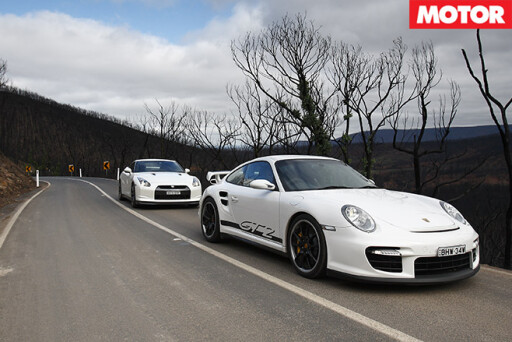 But mind-blowing as its pace may be, the 911 Turbo isn’t track-focused or motorsport-oriented like the GT-R. It’s more about hoovering up autobahns and swallowing challenging alpine country with a well-heeled driver at the helm than setting lap records.
But mind-blowing as its pace may be, the 911 Turbo isn’t track-focused or motorsport-oriented like the GT-R. It’s more about hoovering up autobahns and swallowing challenging alpine country with a well-heeled driver at the helm than setting lap records.
So GT2 it is then, in matching white with sinister black 19s and a love-it-or-hate-it black ‘GT2’ decal decorating both sides. Alongside the sharp-edged, pearl-white GT-R, the Porsche looks far less futuristic and even slightly retro, thanks to its 911SC-style dark wheels and Carrera RS-inspired stripery. But it’s also a much smaller car than the GT-R.
Compare the measurements and you’ll be surprised by just how big the GT-R is, most obviously in a wheelbase that stretches 430mm beyond the Porsche’s. Overall length is closer (it’s only 181mm longer), but the GT-R is also 43mm wider, 85mm taller and, probably most damning, 300kg chunkier.
 If real estate equals presence, then the mean-looking GT-R has it by the container load, but the GT2 is no sheltered petal either, especially in the awesome livery of our brand-spanking-new test car (it had just 1841km on the clock when we collected it).
If real estate equals presence, then the mean-looking GT-R has it by the container load, but the GT2 is no sheltered petal either, especially in the awesome livery of our brand-spanking-new test car (it had just 1841km on the clock when we collected it).
The GT-R’s drama continues as you prepare to take the hot seat. Its concept-car door handles are flush little aluminium blades that you prod with your thumb, then grab with your fingers to open, and its electric seat adjuster is pure genius – a single rotary dial on the side of the seat cushion that you twist for the backrest, push for-and-aft for length and nudge up and down for height.
But the GT-R’s dashboard is a slightly dorky mix of curves and rectangles, like some weird-burger Japanese-domestic hatchback, and the computer-game-inspired centre screen (with 10 different screen-views) juts uneasily from the top of the centre stack, interrupting the flow of the rest of the interior.
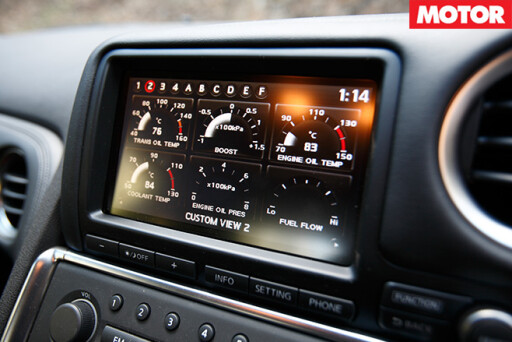 The Porsche, by comparison, is simpler and more familiar, though the ’09-spec GT2 does score the slicker, better-quality sat-nav/audio and climate-control switchgear from last year’s facelifted 911, if not its LED taillights and other tweaks (they’re still to come). You sit much lower in the Porsche on superb, manually adjustable, fixed-back race buckets, and its plastics are more tactile than the Nissan’s, though the GT-R’s padded-leather dash insert is a nice touch.
The Porsche, by comparison, is simpler and more familiar, though the ’09-spec GT2 does score the slicker, better-quality sat-nav/audio and climate-control switchgear from last year’s facelifted 911, if not its LED taillights and other tweaks (they’re still to come). You sit much lower in the Porsche on superb, manually adjustable, fixed-back race buckets, and its plastics are more tactile than the Nissan’s, though the GT-R’s padded-leather dash insert is a nice touch.
The Porsche also has a more-tactile steering wheel (a seductive, triangular, mock-suede number) than the Nissan’s larger, harder wheel, though Japan’s supercar inexplicably includes two flip-down column adjusters – one for height, the other for reach – which must be a world-first, though exactly why is anyone’s guess. To hold the steering wheel more firmly in place?
In fact, ‘firm’ is a word that goes hand in hand with the GT-R. From the moment you flick its dual-clutch transmission into D and cut a head-turning swathe into traffic, the firmness of this car’s suspension is impossible to ignore.
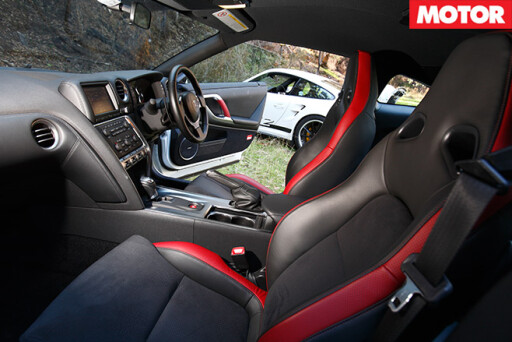 Despite all that weight, the GT-R’s ride is hard, and at times even brutal, because its three-setting Bilstein Damptronic dampers default to the middle ‘normal’ setting at start-up. If you live at the top of Macquarie Pass or on Clyde Mountain or on Victoria’s Black Spur, then lucky you – the GT-R is instantly primed for a twisty-road carve-up – but for the remaining 98 percent of us, flicking the electronic damper toggle to ‘comfort’ is a must before you’ve even left your garage.
Despite all that weight, the GT-R’s ride is hard, and at times even brutal, because its three-setting Bilstein Damptronic dampers default to the middle ‘normal’ setting at start-up. If you live at the top of Macquarie Pass or on Clyde Mountain or on Victoria’s Black Spur, then lucky you – the GT-R is instantly primed for a twisty-road carve-up – but for the remaining 98 percent of us, flicking the electronic damper toggle to ‘comfort’ is a must before you’ve even left your garage.
Crawling north from Melbourne along the ill-surfaced Hume towards Winton Raceway and Wangaratta airport, it takes time to really pin-point the differences between ‘normal’ and ‘comfort’.
In default mode, the Nissan jolts and jiggles incessantly, and tram-lines along channels in the road at slower speeds, but it does all that in cushy mode, too – just to a lesser extent. Blame could be directed at the GT-R’s massive 20-inch Bridgestone Potenza RE070R run-flats because all those criticisms are exactly what tarnished the dynamic reputation of BMW’s first run-flat-equipped 3 Series.
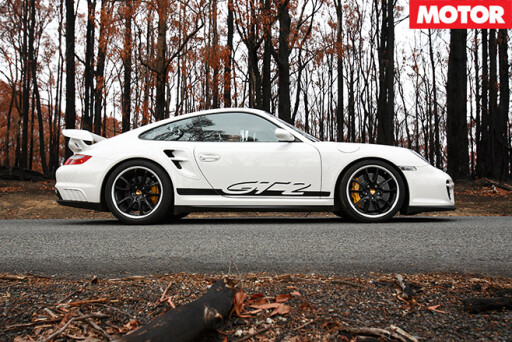 What Damptronic’s ‘comfort’ setting ultimately achieves is a small, but noticeable reduction in the GT-R’s manic nature. It calms things down a bit and rounds off bumps slightly better, though calling the setting ‘comfort’ is like calling Warwick Capper ‘musical’. And the same goes for ‘normal’. There’s absolutely nothing normal about the R35 GT-R…
What Damptronic’s ‘comfort’ setting ultimately achieves is a small, but noticeable reduction in the GT-R’s manic nature. It calms things down a bit and rounds off bumps slightly better, though calling the setting ‘comfort’ is like calling Warwick Capper ‘musical’. And the same goes for ‘normal’. There’s absolutely nothing normal about the R35 GT-R…
…or the GT2, for that matter, though the Porsche does a vastly superior job of plying knobbly Aussie highways than the Nissan. Its PASM damping system employs just two settings – one for the majority of driving situations, the other for racetracks or unusually smooth surfaces – and it defaults to the comfier of the two for an amazingly unobtrusive ride for such a low-slung, track-biased car.
The Porsche is more relaxed engine-wise, too, because it’s doing just 2350rpm at 120km/h in sixth, as opposed to 2650rpm in the Nissan. But you can’t escape the GT2’s considerable tyre noise.
 Regardless of the road surface, its hardcore Michelin Pilot Sport Cups are always roaring away in the background, and even with Porsche’s thumping (optional) Bose stereo cranked right up, you can still vaguely detect the hum. The GT-R, on the other hand, isn’t that loud at all, despite running similarly aggressive cut-slicks.
Regardless of the road surface, its hardcore Michelin Pilot Sport Cups are always roaring away in the background, and even with Porsche’s thumping (optional) Bose stereo cranked right up, you can still vaguely detect the hum. The GT-R, on the other hand, isn’t that loud at all, despite running similarly aggressive cut-slicks.
Peeling off the soporific Hume and onto the runway at Wangaratta airport finally gives us the opportunity to let these animals off the leash. And it’s the GT2 that does the bolt first. When we first performance-tested the mega-Porsche in June ’08, we turned stability-control off, balanced the car on the clutch take-up point, then quickly squeezed in power – clocking 3.9sec to 100km/h (its claim is an achievable 3.7) and 11.7 for the quarter.
But, confusingly, turning ESP off disables ‘Launch Assistant’, so this time we leave it on, rev the 390kW twin-turbo flat six to about four grand, then dump the clutch. And pray. The GT2 reacts by grinding its arse into the ground while simultaneously spearing forward, flickering its ESP dash light as its astonishing grunt hurls it into the distance. 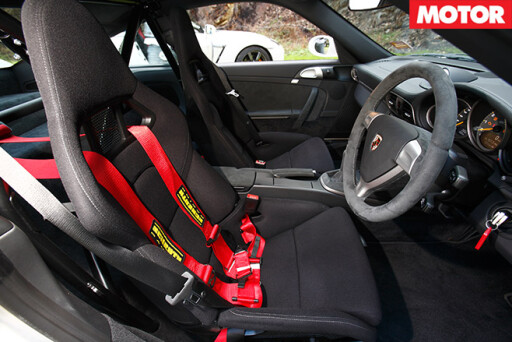 Despite the gravelly surface, a slow shift to third and a tickle of the rev limiter before fourth, the GT2’s first run nails 3.99sec to 100km/h and an 11.91 quarter at 197.57km/h, not to mention a searing 21.39 for the standing kay at 254.45km/h.
Despite the gravelly surface, a slow shift to third and a tickle of the rev limiter before fourth, the GT2’s first run nails 3.99sec to 100km/h and an 11.91 quarter at 197.57km/h, not to mention a searing 21.39 for the standing kay at 254.45km/h.
I’ve performance-tested the GT2 before, but as I ease to a standstill at the end of the runway to write down the numbers, I notice that my hands are actually shaking. Acceleration in the GT2 has that effect. It doesn’t matter how many times you’ve driven one, the intensity of its performance never fails to leave you breathless.
Subsequent acceleration runs result in too much ESP interference as the GT2 rips up the runway’s loose surface, so to avoid sand-blasting the pricey Porsche’s rear haunches with gravel, I swap into the GT-R.
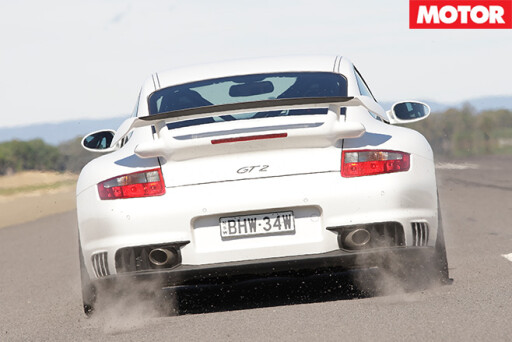 This one is built in January ’09, meaning it’s a 2009-spec official-Aussie example that seems to lack the secretive launch control fitted to 2008-spec cars. And no matter what the procedure – ESP on or off, dampers in race or normal, transmission in drive or manual – the all-paw GT-R categorically refuses to launch itself with the GT2’s force.
This one is built in January ’09, meaning it’s a 2009-spec official-Aussie example that seems to lack the secretive launch control fitted to 2008-spec cars. And no matter what the procedure – ESP on or off, dampers in race or normal, transmission in drive or manual – the all-paw GT-R categorically refuses to launch itself with the GT2’s force.
Eventually, I select the sportiest settings and floor it in Drive while holding it on the brake, tacho steady at two grand, and then let the car do all the work. The GT-R responds by momentarily moving forward, then exploding.
Despite the gravel, there’s no wheelspin at all – just a seamless, unrelenting surge of epic proportions – and nothing for the driver to do other than to hang on. Compared with the Porsche’s blasting, amphetamine-laced turbo whoosh, the Nissan’s 357kW twin-turbo V6 sounds grainier and somehow acoustically related to the old 350Z’s meaty, industrial V6 roar. But it’s just as ballistic.
 The Porsche wins to 60km/h (2.08sec versus 2.20) and up to 150km/h, it really only loses out to the Nissan when there’s a gearchange involved, though it’s an incredibly close fight. Beyond 150km/h, though, the GT2 simply walks away (or rather, sprints) as the GT-R’s inferior power-to-weight starts to impinge on its performance.
The Porsche wins to 60km/h (2.08sec versus 2.20) and up to 150km/h, it really only loses out to the Nissan when there’s a gearchange involved, though it’s an incredibly close fight. Beyond 150km/h, though, the GT2 simply walks away (or rather, sprints) as the GT-R’s inferior power-to-weight starts to impinge on its performance.
By 200km/h, the Porsche is a second ahead. By 240, it’s nearly two seconds, and at the standing-kilometre, the Porsche is travelling more than 10km/h faster. You have to know what you’re doing and work hard to reveal the GT2’s superiority, but it’s there. By God, is it what.
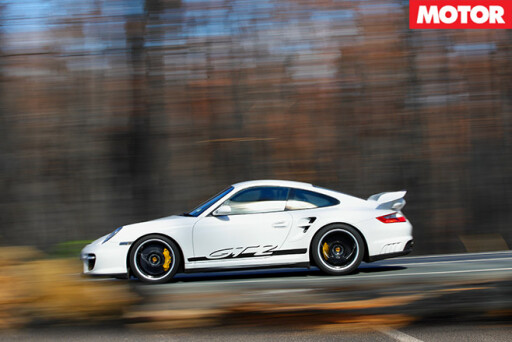 If absolutely anyone could get a GT-R to slay 100km/h in 4.0 seconds, then its dynamics tread a similar path. For a 1740kg car, both the GT-R’s pace and its chassis are phenomenal. From the first corner to the last, the GT-R is working with you, turning you into a hero.
If absolutely anyone could get a GT-R to slay 100km/h in 4.0 seconds, then its dynamics tread a similar path. For a 1740kg car, both the GT-R’s pace and its chassis are phenomenal. From the first corner to the last, the GT-R is working with you, turning you into a hero.
Its change-of-direction is brilliant as it darts from apex to apex, as is its drive out of corners, and its balance and grip are sensational. The GT-R gobbles up tight stuff with staggering ease – its twisty-road agility totally belying its size and weight – but long, fast sweepers start to expose its mass. The GT-R can carry miles of corner speed, but its rubber is working its freckle off, and the subsequent tyre squealing does tend to give the game away a bit.
At speed, the GT-R’s manic ride settles a little, but you need to leave its dampers in ‘normal’ for the best steering and cornering response. In default mode, its front-end simply feels more connected and more interested, with its terrific steering feel at its most heightened. And you can leave ESP activated, too, because the stability-control’s subtlety is genuinely impressive. The GT-R will even serve up power-oversteer exiting a tight corner if you’re ballsy enough.
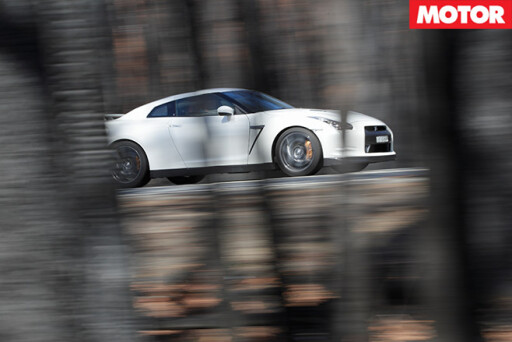 In isolation, then, the GT-R’s handling is brilliant, but up against the GT2, the Nissan is ultimately humbled. On its own, the GT-R feels darty and super-keen, but compared to the much-smaller and lighter GT2, the GT-R’s turn-in is almost lazy.
In isolation, then, the GT-R’s handling is brilliant, but up against the GT2, the Nissan is ultimately humbled. On its own, the GT-R feels darty and super-keen, but compared to the much-smaller and lighter GT2, the GT-R’s turn-in is almost lazy.
The Porsche locates you much closer to the road in a visibly narrower cabin with superb vision, but it’s this car’s exceptional handling that elevates it to a position of true greatness. Where the GT-R turns into a tight corner, the GT2 pivots into one.
You spot the corner, move outwards a touch, then lift off either the throttle or brakes as you turn and the GT2 simply whips its nose into place. With its rear engine, rear-wheel drive and 300kg weight saving, the Porsche simply feels lighter and more adjustable than the Nissan.

Unlike the Nissan, which mildly understeers until you get stuck into it and the rear-drive bias dissolves it, the GT2 simply doesn’t understeer on the road. It can get its power down earlier in a corner than the GT-R and actually oversteers less – giving just a slight drift while charging forward, in corners where the Nissan actually requires a touch of opposite lock.
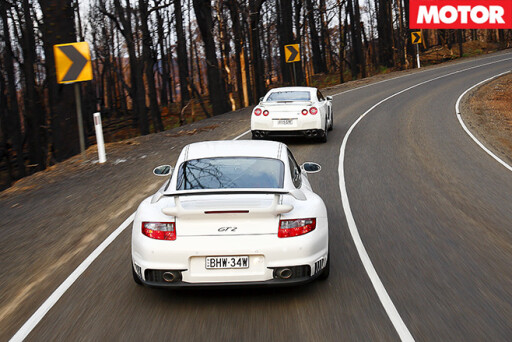 Being a proper, mechanical manual instead of a flappy-paddle set-up has its benefits, too, though the GT-R’s dual-clutcher is a good one when you’re having a thrash, and the length of its fixed shift paddles means you often fluke a mid-corner gearshift with your baby finger, just when you thought you weren’t going to be able to reach.
Being a proper, mechanical manual instead of a flappy-paddle set-up has its benefits, too, though the GT-R’s dual-clutcher is a good one when you’re having a thrash, and the length of its fixed shift paddles means you often fluke a mid-corner gearshift with your baby finger, just when you thought you weren’t going to be able to reach.
The twin-turbo Nissan has crisper and more urgent light-throttle response than the twin-turbo Porsche, too, and while its brakes ultimately aren’t quite up to the ceramic Porker’s stratospheric standards, the GT-R offers better pedal progression and feel than the GT2’s firmness.
Maybe it’s unfair to compare an all-wheel-drive, two-plus-two coupe against a purpose-built lightened one, but try telling that to the Targa Tassie competitors who’ll be pitting the R35 GT-R head-to-head with just about every 911 model you care to name. The GT-R certainly isn’t shamed by any means, and to be brutally honest, it betters the GT2 in few areas.
 Yes, its performance and handling are brilliantly accessible. The GT-R’s superb chassis gives it the agility its weight and size imply it shouldn’t have, to the point where the new Godzilla is destined to make a huge impact in motorpsort. But its abrasive ride is annoyingly over-firm, ruining its chances of being a great cross-country slingshot, and its useless rear seat should come with a complementary visit to a chiropractor.
Yes, its performance and handling are brilliantly accessible. The GT-R’s superb chassis gives it the agility its weight and size imply it shouldn’t have, to the point where the new Godzilla is destined to make a huge impact in motorpsort. But its abrasive ride is annoyingly over-firm, ruining its chances of being a great cross-country slingshot, and its useless rear seat should come with a complementary visit to a chiropractor.
So, hats off for the R35 GT-R, though I don’t know whether it’s worth dropping your pants for. Nothing, and we mean nothing, can match it at its price, but the real benchmark will cost you nearly three times more.

SPECS
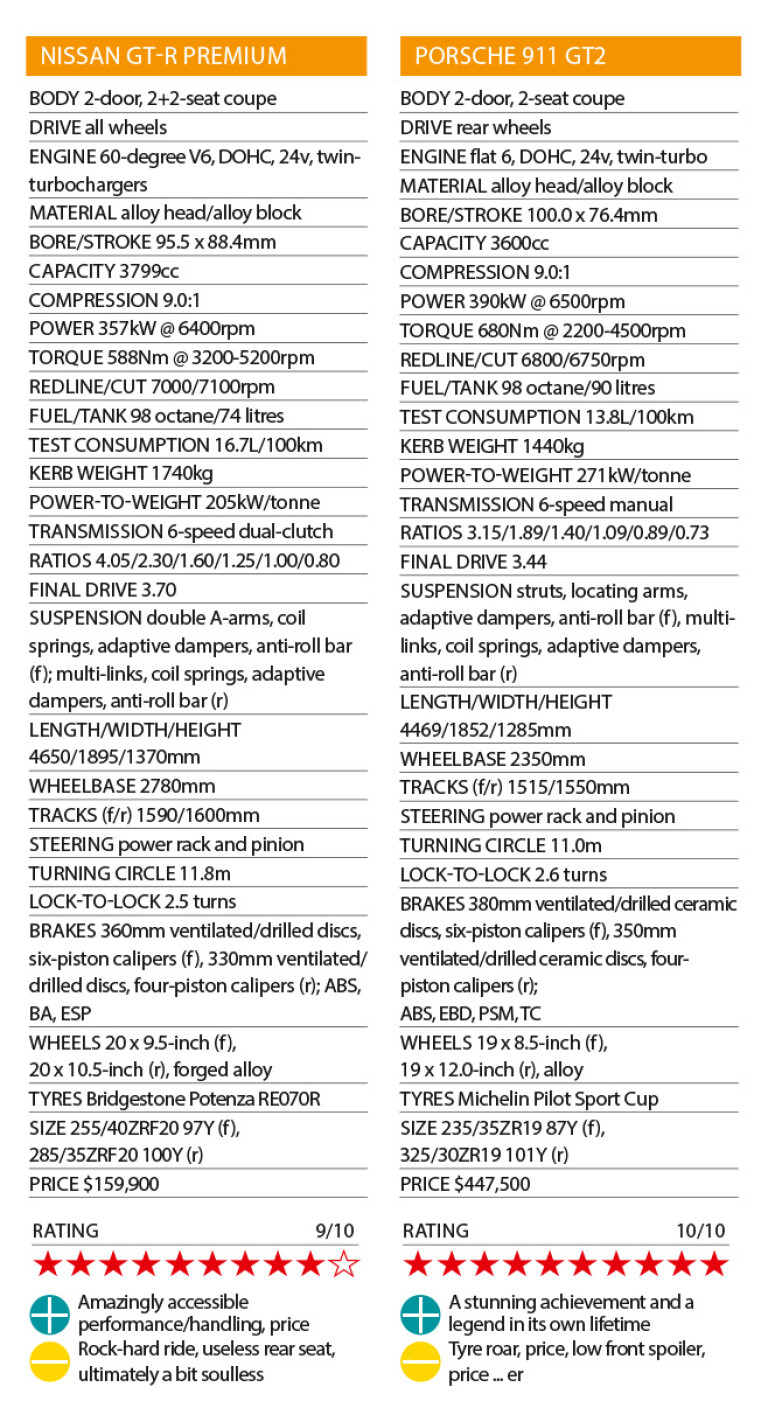
THE NUMBERS
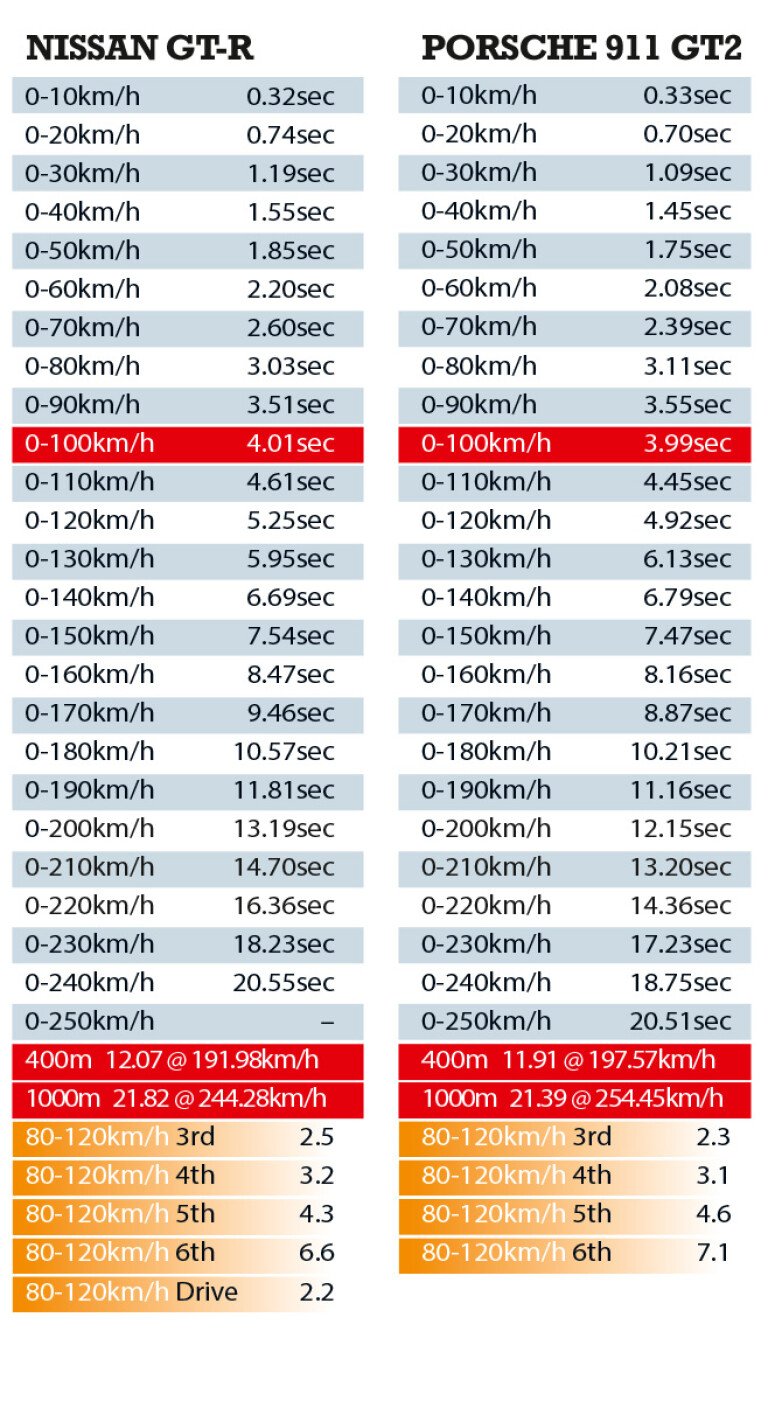

COMMENTS